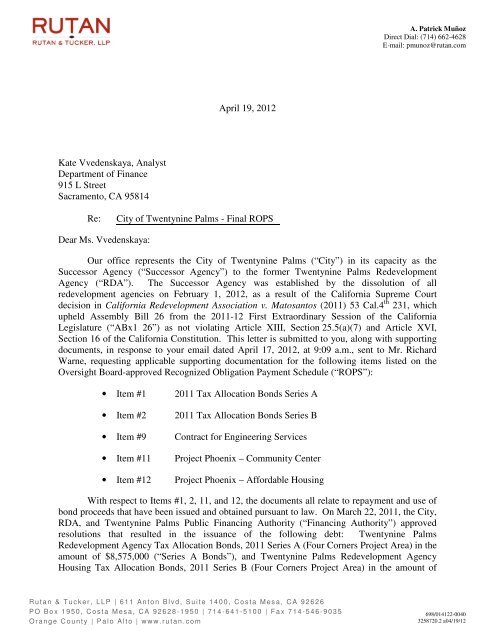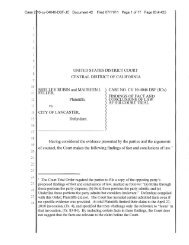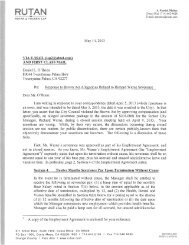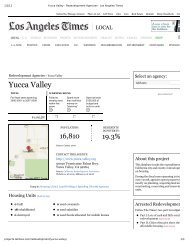response letter from Rutan & Tucker.
response letter from Rutan & Tucker.
response letter from Rutan & Tucker.
You also want an ePaper? Increase the reach of your titles
YUMPU automatically turns print PDFs into web optimized ePapers that Google loves.
A. Patrick Muñoz<br />
Direct Dial: (714) 662-4628<br />
E-mail: pmunoz@rutan.com<br />
April 19, 2012<br />
Kate Vvedenskaya, Analyst<br />
Department of Finance<br />
915 L Street<br />
Sacramento, CA 95814<br />
Re:<br />
City of Twentynine Palms - Final ROPS<br />
Dear Ms. Vvedenskaya:<br />
Our office represents the City of Twentynine Palms (“City”) in its capacity as the<br />
Successor Agency (“Successor Agency”) to the former Twentynine Palms Redevelopment<br />
Agency (“RDA”). The Successor Agency was established by the dissolution of all<br />
redevelopment agencies on February 1, 2012, as a result of the California Supreme Court<br />
decision in California Redevelopment Association v. Matosantos (2011) 53 Cal.4 th 231, which<br />
upheld Assembly Bill 26 <strong>from</strong> the 2011-12 First Extraordinary Session of the California<br />
Legislature (“ABx1 26”) as not violating Article XIII, Section 25.5(a)(7) and Article XVI,<br />
Section 16 of the California Constitution. This <strong>letter</strong> is submitted to you, along with supporting<br />
documents, in <strong>response</strong> to your email dated April 17, 2012, at 9:09 a.m., sent to Mr. Richard<br />
Warne, requesting applicable supporting documentation for the following items listed on the<br />
Oversight Board-approved Recognized Obligation Payment Schedule (“ROPS”):<br />
• Item #1<br />
• Item #2<br />
• Item #9<br />
• Item #11<br />
• Item #12<br />
2011 Tax Allocation Bonds Series A<br />
2011 Tax Allocation Bonds Series B<br />
Contract for Engineering Services<br />
Project Phoenix – Community Center<br />
Project Phoenix – Affordable Housing<br />
With respect to Items #1, 2, 11, and 12, the documents all relate to repayment and use of<br />
bond proceeds that have been issued and obtained pursuant to law. On March 22, 2011, the City,<br />
RDA, and Twentynine Palms Public Financing Authority (“Financing Authority”) approved<br />
resolutions that resulted in the issuance of the following debt: Twentynine Palms<br />
Redevelopment Agency Tax Allocation Bonds, 2011 Series A (Four Corners Project Area) in the<br />
amount of $8,575,000 (“Series A Bonds”), and Twentynine Palms Redevelopment Agency<br />
Housing Tax Allocation Bonds, 2011 Series B (Four Corners Project Area) in the amount of<br />
<strong>Rutan</strong> & Tuc k er, LLP | 6 11 Anton Blvd, Suite 14 0 0, Cos t a Mes a, CA 9262 6<br />
PO Box 1 950, Cos t a Mes a, CA 9262 8-19 50 | 7 14- 641-5100 | F a x 7 14-54 6-903 5<br />
O r ange County | P alo Alto | ww w.rutan.com<br />
698/014122-0040<br />
3258720.2 a04/19/12
Kate Vvedenskaya, Analyst<br />
April 19, 2012<br />
Page 2<br />
$3,000,000 (“Series B Bonds”). (The Series A Bonds and Series B Bonds are collectively<br />
referred to as the “Bonds”). Repayment of the Series A Bonds was secured by the RDA’s nonhousing<br />
tax increment funds, and repayment of the Series B Bonds was secured by the RDA’s<br />
“20% Set-Aside” housing tax increment, commonly known as “Low and Moderate Income<br />
Housing Funds,” which must be used to increase and improve the City’s supply of low- and<br />
moderate-income housing.<br />
The Bonds, both the Series A Bonds and Series B Bonds, are designated tax-exempt.<br />
The Bonds were sold on April 19, 2011. The final maturity date for the Bonds is<br />
September 1, 2042, and the first optional call date is September 1, 2021.<br />
Pursuant to two Indentures of Trust dated March 1, 2011, one agreement for the Series A<br />
Bonds and the other for the Series B Bonds (collectively, the “Indentures”), between the RDA<br />
and U.S. Bank National Association, as trustee, the proceeds <strong>from</strong> the sale of the Bonds, after<br />
deducting costs of issuance and coverage for reserve accounts, were transferred and deposited in<br />
the “Project Fund” established under the Indenture for the Series A Bonds, and into the “Low<br />
and Moderate Income Housing Fund” for the Series B Bonds. (See, Indenture of Trust for Tax<br />
Allocation Bonds, 2011 Series A, § 3.04; Indenture of Trust for Housing Tax Allocation Bonds,<br />
2011 Series B, § 3.04.) Based on information <strong>from</strong> Successor Agency staff, trustee U.S. Bank<br />
National Association had, on March 31, 2012, $7,412,014 in proceeds <strong>from</strong> the Series A Bonds<br />
and $2,565,674 in proceeds <strong>from</strong> the Series B Bonds, not including amounts in the reserve funds.<br />
The proceeds <strong>from</strong> the Series A Bonds and Series B Bonds are collectively referred to in this<br />
<strong>letter</strong> as the “Bond Proceeds.”<br />
The Official Statement for the Bonds, dated April 19, 2011, issued by Wedbush<br />
Securities, Inc. (“Official Statement”), provides that proceeds <strong>from</strong> the Series A Bonds are to be<br />
used to fund public improvements related to Project Phoenix and other projects in the RDA’s 5-<br />
Year Implementation Plan, and that proceeds <strong>from</strong> the Series B Bonds are to be used to fund<br />
housing activities included in the RDA’s 5-Year Implementation Plan for the Project Area (i.e.,<br />
Four Corners Project Area, or “Project Area”). (Official Statement, p. 13.)<br />
The current and applicable 5-Year Implementation Plan includes Project Phoenix (which<br />
itself is in the Project Area), related public improvements (such as the community center and<br />
waste water management facility), and new affordable housing development within the Project<br />
Area. (5-Year Implementation Plan, pp. 16-17, 28.) 1<br />
1<br />
A copy of the current 5-Year Implementation Plan, incorporated by reference into the Bond<br />
documents, is included along with the materials accompanying the <strong>response</strong> <strong>from</strong> the Successor<br />
Agency.<br />
698/014122-0040<br />
3258720.2 a04/19/12
Kate Vvedenskaya, Analyst<br />
April 19, 2012<br />
Page 3<br />
Furthermore, Section 5.13 of the Indenture for the Series A Bonds includes the following<br />
covenant:<br />
The Agency hereby declares its intent, and so covenants for the<br />
benefit of the owners, to utilize the proceeds of the Bonds solely<br />
and exclusively for the elimination of blight and lawful and proper<br />
redevelopment purposes and projects within the Project Area, or<br />
which provide direct benefit to the Project Area, in that the owners<br />
are provided a pledge and lien upon tax increment generated in the<br />
Project Area and the increase in tax increment produced by the<br />
expenditure of the proceeds of the Bonds for the redevelopment<br />
purposes within or for the benefit of the Project Area produces<br />
clear and material benefit to the security and credit of the owners.<br />
Additionally, Section 5.12 of the Indenture for the Series B Bonds includes the following<br />
covenant:<br />
The Agency shall take all actions necessary to assure the exclusion<br />
of interest on the Bonds <strong>from</strong> the gross income of the Owners of<br />
the Bonds to the same extent as such interest is permitted to be<br />
excluded <strong>from</strong> gross income under the Tax Code as in effect on the<br />
Closing Date.<br />
The covenants cited above are only a sampling of the many terms and conditions that<br />
dictate how the Bond Proceeds are to be used, and how the Bonds’ tax exempt status is to be<br />
preserved. In short, these covenants require that the Bond Proceeds be utilized for projects<br />
indentified in the Project Area, including specifically Project Phoenix. These covenants in the<br />
Bonds are to be honored so that the Successor Agency can comply, not only with the language in<br />
ABx1 26, but also with the intent of the Legislature as expressed in:<br />
• Health and Safety Code section 34174(a), which provides that “nothing in this<br />
act [ABx1 26] adding this part [Part 1.85 of Division 24 of the Health and Safety<br />
Code] is intended to be construed as an action or circumstance that may give rise<br />
to an event of default under any of the documents governing the enforceable<br />
obligations.” [Emphasis added.]<br />
• Health and Safety Code section 34175(a), which provides, “It is the intent of this<br />
part [Part 1.85 of Division 24 of the Health and Safety Code] that pledges of<br />
revenues associated with enforceable obligations of the former redevelopment<br />
agencies are to be honored. It is intended that the cessation of any<br />
redevelopment agency shall not affect either the pledge, the legal existence of<br />
698/014122-0040<br />
3258720.2 a04/19/12
Kate Vvedenskaya, Analyst<br />
April 19, 2012<br />
Page 4<br />
that pledge, or the stream of revenues available to meet the requirements of the<br />
pledge.” [Emphasis added.]<br />
Health and Safety Code section 34171(d), added by ABx1 26, defines “enforceable<br />
obligations” to include, among other types of agreements and arrangements, bonds, including<br />
required debt service, reserve set-asides, and any other payments required under the indenture or<br />
similar documents governing the issuance of outstanding bonds.<br />
It is beyond doubt that the Bonds issued by the RDA are “enforceable obligations” under<br />
ABx1 26. As such, the City, as Successor Agency, has the duty to perform and honor the<br />
covenants required by the Bonds. (Health & Saf. Code § 34177(c) [“Successor agencies are<br />
required to . . . Perform obligations required pursuant to any enforceable obligation.”].)<br />
Even more, ABx1 26 includes additional mandatory provisions applicable to the Bonds.<br />
For instance, successor agencies must “maintain reserves in the amount required by indentures,<br />
trust indentures, or similar documents governing the issuance of outstanding redevelopment<br />
agency bonds.” (Health & Saf. Code § 34177(b).) Additionally, successor agencies are required<br />
to:<br />
Continue to oversee development of properties until the contracted<br />
work has been completed or the contractual obligations of the<br />
former redevelopment agency can be transferred to other parties.<br />
Bond proceeds shall be used for the purposes for which bonds<br />
were sold unless the purposes can no longer be achieved, in which<br />
case, the proceeds may be used to defease the bonds.<br />
(Health & Saf. Code § 34177(i) [Emphasis added].)<br />
It is a long-standing canon of statutory construction that the word “shall” is construed as<br />
“mandatory” (as opposed to “discretionary”). (Tarrant Bell Property, LLC v. Superior Court<br />
(2011) 51 Cal.4th 538, 542, quoting Common Cause v. Board of Supervisors (1989) 49 Cal.3d<br />
432, 443[“we ‘ordinarily’ construe the word ‘may’ as permissive and the word ‘shall’ as<br />
mandatory, ‘particularly’ when a single statute uses both terms”].) Accordingly, if the purposes<br />
for which bonds were sold can be achieved, the bond proceeds must be used for those purposes.<br />
Such is the situation with the Bond Proceeds here. The express purpose of the Bonds, as<br />
explained in the Indentures and Official Statement, is to fund redevelopment and affordable<br />
housing activities in the Project Area, with specific reference to Project Phoenix and public<br />
improvements related thereto.<br />
The Department of Finance (the “Department”) appears to have recognized this type of<br />
situation with Bonds such as those identified here. In the Department’s document available on<br />
698/014122-0040<br />
3258720.2 a04/19/12
Kate Vvedenskaya, Analyst<br />
April 19, 2012<br />
Page 5<br />
its Internet Website, entitled “Redevelopment Agency Dissolution Under ABx1 26 – Frequently<br />
Asked Questions,” the Department notes:<br />
Specific situations involving bonds that have been sold but for<br />
which the specific things to be done with the bond proceeds are not<br />
obligated through contracts for performance will have to be<br />
reviewed to see if obligations to bond holders require such<br />
contracts to be made by successor agencies or whether bonds must<br />
be defeased.<br />
As discussed above, the obligations to the bond holders expressed by the covenants in the<br />
Indentures and Official Statement (and other documents provided) require such contracts for the<br />
use of the Bond Proceeds so that public improvements related to Project Phoenix and affordable<br />
housing in the Project Area can be completed. In other words, the purposes for which the Bonds<br />
were sold can – and must – still be achieved. (Health & Saf. Code § 34177(i).)<br />
Conversely, the ability to realistically defease the Bonds cannot occur, due to the<br />
September 1, 2021 first optional call date. Moreover, simply transferring the Bond Proceeds to<br />
the county auditor-controller for disbursement to other taxing entities (Health & Saf. Code<br />
§ 34177(d)) is not an option, due to the tax-exempt status of the Bonds.<br />
The City Attorneys’ Department for the Post-Redevelopment Working Group of the<br />
League of California Cities issued “Questions & Answers” dated March 23, 2012, concerning,<br />
among other topics, bond proceeds. In that Q&A, the guidance provides:<br />
Q: Should the Successor Agency not remit bond proceeds in particular<br />
instances<br />
A: The general consensus is that tax-exempt bond proceeds should not be<br />
remitted to the A/C [auditor-controller] because the use -- distribution to<br />
other taxing entities -- could be inconsistent with the authorized use of tax<br />
exempt bonds, leading to serious consequences under federal law.<br />
Our office agrees. The Indentures have covenants that require the RDA to maintain taxexempt<br />
status of the Bonds for the benefit of the bond holders. As long as the Bond Proceeds are<br />
used for their covenanted purposes (i.e., public improvements related to Project Phoenix and<br />
affordable housing in the Project Area), they should remain tax-exempt. (See Official Statement<br />
– LEGAL MATTERS – Tax Matters, pp. 47-48.) However, the issuing agency’s failure to<br />
comply with the bond covenants could result in the Bonds losing their tax-exempt status, which<br />
would have significant tax consequences for bond holders. (Ibid.)<br />
698/014122-0040<br />
3258720.2 a04/19/12
Kate Vvedenskaya, Analyst<br />
April 19, 2012<br />
Page 6<br />
For all of the reasons stated above, the Successor Agency and our office submit to the<br />
Department that the Bonds (which includes all documents relating thereto) are “enforceable<br />
obligations” under ABx1 26, and pursuant to multiple covenants, the Bond Proceeds must be<br />
used for purposes identified in the Bonds. As such, Items #1, 2, 11, and 12 should remain on the<br />
ROPS as enforceable obligations.<br />
The same is true for Item #9, a Contract Services Agreement for Pre-Engineering and<br />
Environmental Services for the Highway 62 Improvement Project between the City and Dokken<br />
Engineering (“Dokken Services Contract”). This is an agreement entered into on October 13,<br />
2009, for work done in connection with publicly owned improvements, namely street widening,<br />
adding curb, gutter and sidewalk improvements, and providing drainage facilities along State<br />
Route 62 <strong>from</strong> Encelia Road to Split Rock Road, which runs through and adjacent to the Project<br />
Area. The publicly owned improvements required compliance with the California<br />
Environmental Quality Act (“CEQA”), specified requirements by CalTrans, and, because federal<br />
funds were anticipated to be used, the National Environmental Policy Act (“NEPA”). (Dokken<br />
Services Contract, Exhibit A, p. 1.) Additionally, the publicly owned improvements would be<br />
funded, in part, by federal funding once engineering and environmental clearance had been<br />
obtained. (Id.) In accordance with Health and Safety Code section 33445, the applicable law at<br />
the time of the contract, the RDA allocated up to $250,000 to assist in payment of these<br />
engineering and environmental study services needed to comply with CEQA and NEPA. (See,<br />
Reso. No. 09-05; Reso. No. RDA 09-01; Staff Report for Dokken Services Contract, pp. 1-2;<br />
Oct. 13, 2009 Meeting Minutes, Item #10.3.) 2 Under ABx1 26, “enforceable obligations”<br />
include payments “required by the federal government,” “preexisting obligations to the state,”<br />
and/or required by “obligations imposed by state law.” (Health & Saf. Code § 34171(d)(1)(C).)<br />
Moreover, as set forth in the relevant documents approving the Dokken Services Contract<br />
(provided along with this <strong>letter</strong>), payments for the services under the Dokken Services Contract<br />
were to be funded by the RDA. As such, the RDA has the obligation to pay the remaining costs<br />
incurred by Dokken for work completed under the contract.<br />
In closing, our office sends this <strong>letter</strong> to clearly delineate the Successor Agency’s position<br />
concerning Items #1, 2, 9, 11, and 12 on the ROPS as being obligations that are enforceable and<br />
are to be honored with the source of payment identified in the ROPS. Information contained in<br />
this <strong>letter</strong>, and any and all further <strong>response</strong>s and information that may be provided to the<br />
Department, are being provided as an accommodation to your office. The City, acting in its<br />
capacity as the Successor Agency, does not intend to waive any constitutional, statutory, legal, or<br />
equitable rights, and expressly reserves any and all rights, privileges, and defenses available<br />
under law and equity, including but not limited to any causes of action under Article I, Section<br />
2<br />
A copy of Resolution No. 09-05, Resolution No. RDA 09-01, the staff report, and meeting<br />
minutes, are included along with the materials accompanying the <strong>response</strong> <strong>from</strong> the Successor<br />
Agency.<br />
698/014122-0040<br />
3258720.2 a04/19/12
Kate Vvedenskaya, Analyst<br />
April 19, 2012<br />
Page 7<br />
10 of the United States Constitution and Article I, Section 9 of the California Constitution, for an<br />
unconstitutional impairment of contracts caused by any action of the Department or any other<br />
State agency that impairs the Successor Agency’s ability to honor the covenants in the<br />
enforceable obligations.<br />
Thank you for your consideration.<br />
RUTAN & TUCKER, LLP<br />
APM:lr<br />
A. Patrick Muñoz<br />
698/014122-0040<br />
3258720.2 a04/19/12





